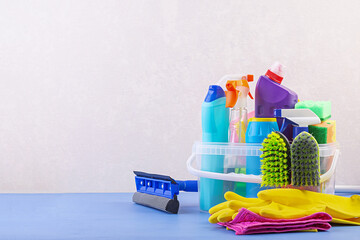How Can I Safely Use Commercial Cleaning Chemicals

Commercial cleaning chemicals are essential for maintaining cleanliness and hygiene in various industries. From offices and restaurants to hospitals and manufacturing facilities, these chemicals play a crucial role in keeping our surroundings clean and free from harmful bacteria and viruses. However, it is important to handle these chemicals with care to ensure the safety of both users and the environment. In this article, we will explore the best practices for safely using commercial cleaning chemicals.
Introduction
Cleaning chemicals are designed to remove dirt, stains, and germs efficiently. However, they can also pose certain risks if not handled properly. By following safety guidelines and taking necessary precautions, you can minimize the potential hazards associated with these chemicals and create a safe working environment.
Understanding Commercial Cleaning Chemicals

Before delving into safety measures, it is important to have a basic understanding of the different types of commercial cleaning chemicals available. These include disinfectants, detergents, degreasers, and sanitizers, each formulated for specific cleaning purposes. Familiarize yourself with the various chemicals you use and their intended applications.
Importance of Safety Measures
The use of commercial cleaning chemicals requires strict adherence to safety guidelines. Failure to do so can result in accidents, health issues, and environmental damage. Understanding the potential risks and hazards associated with these chemicals is crucial for protecting yourself and others.
Potential Risks and Hazards
Commercial cleaning chemicals can be corrosive, toxic, or flammable. They may cause skin and eye irritation, respiratory problems, or even chemical burns if mishandled. Some chemicals may also react dangerously if mixed with incompatible substances. Recognizing and mitigating these risks is essential.
Adherence to Safety Guidelines
To ensure safety, it is vital to follow the instructions provided by the chemical manufacturer. These guidelines typically include information on proper usage, handling, and storage. Make sure to read and understand the safety data sheets (SDS) for each chemical you work with. SDS provides detailed information about the hazards, precautions, and emergency procedures associated with a specific chemical.
Personal Protective Equipment (PPE)

Personal protective equipment (PPE) is a crucial aspect of chemical safety. It provides a barrier between the user and potentially harmful substances. Different cleaning tasks may require different types of PPE, but some common examples include gloves, goggles, aprons, and respirators. Always wear the appropriate PPE when handling cleaning chemicals.
Types of PPE
Gloves are one of the most important pieces of PPE when working with cleaning chemicals. Nitrile or latex gloves provide adequate protection against most chemicals. Goggles or safety glasses protect the eyes from splashes or fumes. Aprons or coveralls shield the body from direct contact. Respirators are necessary when working with chemicals that release harmful vapors or particles into the air.
Proper Usage and Maintenance
It is essential to use PPE correctly to ensure maximum effectiveness. Gloves should fit snugly and cover the wrists. Goggles or safety glasses should fit securely and not obstruct vision. Regularly inspect and replace damaged or worn-out PPE. Clean and store them appropriately to maintain their functionality.
Proper Handling and Storage
Proper handling and storage of cleaning chemicals contribute significantly to overall safety. Paying attention to labels, compatibility, and storage conditions is essential to avoid accidents and chemical reactions.
Reading Labels and Instructions
Always read the labels and instructions provided with the cleaning chemicals. Labels contain important information about the chemical's properties, hazards, and precautionary measures. Follow the instructions regarding dilution, mixing, and usage to prevent mishaps.
Compatibility and Segregation
Certain chemicals are incompatible and can react dangerously when mixed. Store chemicals separately based on their compatibility to avoid potential reactions. Incompatible chemicals should never be stored together, as they can cause fires, explosions, or the release of toxic gases.
Storage Conditions
Proper storage conditions are crucial for chemical stability and safety. Ensure that chemicals are stored in well-ventilated areas away from direct sunlight, heat sources, and moisture. Flammable substances should be stored in approved cabinets or areas designated for flammable materials.
Dilution and Mixing Procedures

Many commercial cleaning chemicals require dilution or mixing before use. It is essential to follow proper procedures to ensure the desired cleaning effect while minimizing risks.
Proper Ratios and Measurements
When diluting chemicals, carefully follow the recommended ratios and measurements provided by the manufacturer. Using too much or too little can affect the cleaning efficiency or compromise safety. Measuring tools such as graduated cylinders or digital scales can help achieve accurate results.
Order of Mixing
If multiple chemicals need to be mixed, always add them in the specified order. Adding chemicals in the wrong sequence can lead to violent reactions or the release of hazardous gases. Follow the instructions to ensure safe mixing.
Precautions for Hazardous Substances
Some chemicals, such as concentrated acids or ammonia-based cleaners, require extra precautions during dilution and mixing. Always wear appropriate PPE and work in well-ventilated areas. If unsure about handling hazardous substances, seek guidance from experts or consider using safer alternatives.
Ventilation and Air Quality

Proper ventilation is crucial when working with cleaning chemicals. It helps maintain a safe environment by minimizing exposure to potentially harmful fumes or gases.
Importance of Adequate Ventilation
Adequate ventilation ensures the removal of airborne contaminants and helps maintain air quality. If working indoors, open windows and doors or use mechanical ventilation systems to ensure fresh air circulation. Proper ventilation is particularly important when using chemicals in confined spaces.
Air Quality Monitoring
Regularly monitor the air quality in areas where cleaning chemicals are used. Install air quality monitors or use air testing kits to detect any potentially harmful substances in the atmosphere. If hazardous levels are detected, take appropriate measures to improve ventilation or reconsider the use of certain chemicals.
Safe Application and Usage
To ensure safe usage of commercial cleaning chemicals, it is important to adopt proper application methods and minimize direct contact.
Avoiding Direct Contact
Avoid direct contact with cleaning chemicals as much as possible. When using sprays or liquids, maintain a safe distance and use tools like mops or cloths to apply the chemicals. If direct contact occurs, rinse the affected area with water immediately.
Appropriate Application Methods
Different cleaning tasks require different application methods. Ensure you are using the correct method for each cleaning chemical and surface. For example, spray cleaners may be suitable for large areas, while wipes or sponges may be more appropriate for smaller or delicate surfaces.
Time and Contact Limitations
Some cleaning chemicals require a specific amount of contact time to achieve optimal results. Follow the manufacturer's instructions regarding contact time and avoid rinsing or wiping off the chemical prematurely. Additionally, limit prolonged exposure to chemicals by minimizing the time spent in the cleaning area.
Emergency Preparedness
Despite taking precautions, accidents can still happen. Being prepared to handle emergencies is essential for ensuring the safety of everyone involved.
First Aid Procedures
Ensure that first aid supplies, such as eyewash stations, safety showers, and chemical spill kits, are readily available in areas where cleaning chemicals are used. Train employees on first aid procedures for chemical exposures and provide clear instructions on how to respond to different types of incidents.
Spill and Leak Response
In the event of a spill or leak, it is important to act swiftly to prevent further damage. Follow the manufacturer's instructions for spill cleanup and containment. Use appropriate personal protective equipment and dispose of contaminated materials properly. If the spill is significant or hazardous, contact the appropriate authorities for assistance.
Emergency Contact Information
Keep a list of emergency contact numbers, including poison control, local fire department, and medical facilities, in a visible and easily accessible location. Ensure that all employees are aware of this information and know when and how to contact the appropriate authorities in case of an emergency.
Disposal of Chemicals
Proper disposal of cleaning chemicals is crucial to prevent environmental contamination and harm to human health.
Environmental Considerations
Some cleaning chemicals may be hazardous to the environment if not disposed of properly. Follow local regulations and guidelines when it comes to chemical waste disposal. Consider using environmentally friendly alternatives whenever possible.
Proper Waste Disposal Practices
Dispose of chemical waste in designated containers or through authorized waste management services. Never pour chemicals down drains, toilets, or stormwater drains, as they can contaminate water sources. Properly label and store chemical waste until it can be safely removed.
Training and Education
Proper training and education play a vital role in ensuring the safe use of commercial cleaning chemicals. Continuous learning and updates are key to staying up-to-date with best practices and new safety measures.
Employee Training Programs
Implement comprehensive training programs for employees who work with cleaning chemicals. Provide detailed information on the proper handling, usage, and storage of chemicals. Include practical demonstrations and opportunities for employees to ask questions and seek clarification.
Continuing Education and Updates
Regularly provide refresher courses and updates on safety procedures and guidelines. Stay informed about new developments in the field of cleaning chemicals and share this knowledge with employees. Encourage ongoing education to foster a safety-conscious culture.
Regular Maintenance and Inspection
Regular maintenance and inspection of cleaning equipment and storage areas are essential to ensure safety and prevent accidents.
Perform routine checks on equipment such as sprayers, containers, and storage cabinets. Repair or replace damaged or malfunctioning equipment promptly. Inspect storage areas for leaks, spills, or signs of deterioration. Proper maintenance and inspection help identify and address potential safety hazards before they become more significant issues.
Common Mistakes to Avoid

Even with knowledge and proper training, certain mistakes can still occur. Being aware of these common errors can help minimize risks and ensure safer practices.
Some common mistakes to avoid when using commercial cleaning chemicals include:
- Neglecting to wear appropriate PPE
- Mixing incompatible chemicals
- Using chemicals in poorly ventilated areas
- Incorrect dilution or measurement of chemicals
- Storing chemicals improperly
- Failure to read and understand labels and instructions
Stay vigilant and avoid these mistakes to maintain a safe working environment.
Benefits of Using Environmentally Friendly Alternatives
While commercial cleaning chemicals are necessary, it is worth exploring environmentally friendly alternatives. These alternatives provide effective cleaning while reducing the impact on the environment and human health.
Environmentally friendly cleaning products are typically formulated with biodegradable ingredients and have a reduced impact on air and water quality. They are safer to use and often carry third-party certifications indicating their eco-friendly nature. By opting for these alternatives, you contribute to a cleaner and more sustainable future.
Conclusion
Using commercial cleaning chemicals safely is crucial for protecting both individuals and the environment. By understanding the potential risks, following safety guidelines, and implementing proper handling, storage, and disposal practices, you can minimize the hazards associated with these chemicals. Remember to wear appropriate PPE, maintain good ventilation, and educate yourself and others through training programs. By prioritizing safety, you create a clean and healthy environment for everyone involved.For hire the best cleaning service in Canada!
FAQs (Frequently Asked Questions)
Q: Are commercial cleaning chemicals safe to use?
A: Commercial cleaning chemicals are generally safe to use when proper safety measures are followed. Adhering to guidelines, using appropriate PPE, and receiving adequate training are key to ensuring safety.
Q: Can I mix different cleaning chemicals together?
A: No, mixing different cleaning chemicals can be dangerous. It may result in chemical reactions, release of toxic gases, or even explosions. Always follow the manufacturer's instructions and avoid mixing incompatible substances.
Q: What should I do if I accidentally come into direct contact with a cleaning chemical?
A: If direct contact with a cleaning chemical occurs, immediately rinse the affected area with water. If any symptoms persist or worsen, seek medical attention promptly.
Q: Can I dispose of cleaning chemicals down the drain?
A: No, it is not recommended to dispose of cleaning chemicals down the drain. Chemicals can contaminate water sources and harm the environment. Follow local regulations and guidelines for proper disposal methods.
Q: Are environmentally friendly cleaning products effective?
A: Yes, environmentally friendly cleaning products can be just as effective as traditional cleaning chemicals. They are formulated with biodegradable ingredients and have a reduced impact on the environment and human health.
Welkom bij
Beter HBO
© 2025 Gemaakt door Beter HBO.
Verzorgd door
![]()

Je moet lid zijn van Beter HBO om reacties te kunnen toevoegen!
Wordt lid van Beter HBO